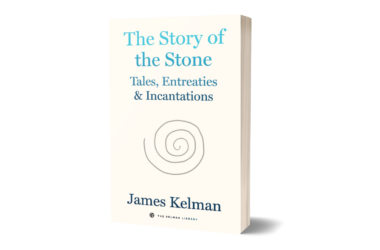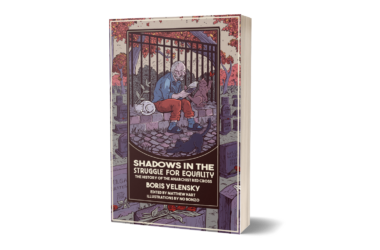By Paul Buhle
Comics Grinder
April 11th, 2025
When is a comic better described as an illustrated text? This question goes back to the distant pre-origins of comics in the hand-drawn, pre-printed “illuminated texts” that kept workers in primitive factories on certain streets of fourteenth century Paris. Perhaps the distinction is not even important, except as evidence that “comics” today are undergoing constant evolution not excluding the very subject. Call Anarchy in the Big Easy an art book of a certain kind, and call it an experiment in anarchist reinterpretation of history.
There is a grand story to tell, and writers of every kind, especially novelists but doubtless also generations of talented journalists, have poked away at the anarchistic spirit of the city. How could it be otherwise? More Caribbean than any other US city of size, more interracial or transracial, with the distinctions of color (and the privilege conveyed) astonishing, almost as astonishing as the birth of jazz, with comics the most important contribution of the US to global culture (films would be third, but mainly for the scale of Hollywood).
What is it about New Orleans? An eco-history is, here, vastly helpful. The natural sustenance offered in edible (also buildable) plant life, along with the vast range of seafood, made for one of the most productive Native life in what would become the USA. Also, and this is a large point, the need for others thousands of years ago to cultivate varieties of what would become corn, demanding enormous care, could be here evaded, allowing looser organizations of communities, and arguably less class structure.
All this is thrown into chaos by the Old World invasion, reducing the estimated population by at least two-thirds, as of 1750. From here on, escape into the backwoods and attempts to built insular communities became mandatory, and with a difference: escaped black slaves escaping with, merging with, others who survived.
Liberated socieities of Maroons, escapees, certainly opened the way for these groups and others, even the enslaved Filipinos who escaped Spanish ships. Not surprisingly, theorists of what would be called anarchism found inspiration here. The text references Elisee Reclus, a true giant of nineteenth century anarchism, who spent some years here, learning and writing. Then we turn to Joseph Dejacque, rediscovered in recent decades as a visionary with his vision of utopia that he called “Harmonic Anarchy.” From the Left, Dejacque assaulted Prudhon himself as the enemy of women’s freedom.

The 1853 novel Mysteries of New Orleans, by a German immigrant intellectual, gives Anarchy in the Big Easy an opening for a more sweeping literary-anarchist overview, but by this time, the book is already moving from literature to social and labor history. Many are the stories of solidarity from the era of Populism to the high days of the IWW to the streetcar strike of 1929, with massive popular support, to the emergence of Black Nationalism and the larger meanings of the annual, Mardi Gras Carnival of the People.
That Carnival, its triumphs and struggles amidst the vast and mostly white tourist outpouring, makes up the rest of the book’s final section. The latest culture or cultures of resistance, over perhaps forty years, seem more obviously anarchic in mobilization, involving more volunteerism of the humanitarian kind, than what we have understood as Left organization or mobilization.
Is it New Orleans or is this the shape of radical activity in our era, when even the most modest political reform seems to fall to defeat or become corrupted by the nearness of power? The virtue of Anarchy in the Big Easy is that the present seems very much in tune with the radical, humanitarian past before the Spanish arrived.
With one big caveat: we are still on the run.
The art of Anarchy could be described as “thin,” or perhaps minimalist, really sketches that seem to want the reader to fill in the gaps. It suits the purpose of the volume.






